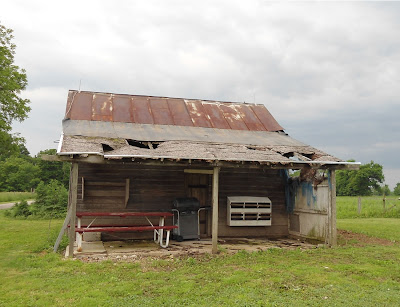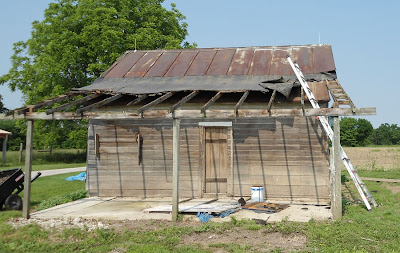Typical of Ohio, the weather here has skipped straight from cold and water-logged to hot and oppressively humid. It's made outdoor work the last few weekends quite exhausting, but we've continued to pluck away at the shed regardless. The pictures below go through two weekends of work on the east side of the shed.
I'll start with a couple of pictures just after we bought the property in October of 2009:
And the progress made over the last 8 days:
All work was supervised by a very concerned crowd of Einsel Shed bees:
I've managed not to get stung yet, although I'm sure by posting that fact I'm condemning myself to at least two bee stings the next time I venture by the shed.
The last section of the old roof is proving the most difficult to remove. It's j..u..s..t out of comfortable reach from any ladder, and although I attempted to climb onto the barn roof proper the pitch was steep enough that I crawled back down immediately. Heights are not one of my strong points.
This last section of roof is also complicated by the fact that it's not as rotted out as the lower portion of the roof. The nails and staples still have some bite in the plywood up here. And there is a heavy rubber mat (that gets very very hot from the sun) nailed over this part of the roof. Underneath that is a layer of black asphalt shingles with their own set of nails. And underneath that is a layer of tar paper (also nailed on). Under the tar paper is finally plywood, held in place along each joist by alternating nails and staples each about an inch apart.
You can kind of see the three layers of roofing materials in this picture:
I doubt there will be any further work on the shed today. We've got church and a family get together in the afternoon. (And I want more time to plot a good way to get at that last foot and a half of roof still to remove.)









Try lighting a fire with very wet wood... guarinteed to create more smoke than true flame, and the bees should move out or expire. Of course if they are the type you want to keep for pollination of plants or anything, then I do not have a clue as to how to get rid of them. Is there any honey?? Aunt J.
ReplyDeleteMost of them are actually wasps and not honeybees. Charles usually has fun playing with fire, but he also enjoys the aeresol cans of Raid that boast on their ability to send a 27 foot jet-spray of death at any unwanted critter with six or more legs. :)
ReplyDelete